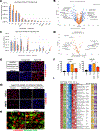Changes in Aged Fibroblast Lipid Metabolism Induce Age-Dependent Melanoma Cell Resistance to Targeted Therapy via the Fatty Acid Transporter FATP2
- PMID: 32499221
- PMCID: PMC7483379
- DOI: 10.1158/2159-8290.CD-20-0329
Changes in Aged Fibroblast Lipid Metabolism Induce Age-Dependent Melanoma Cell Resistance to Targeted Therapy via the Fatty Acid Transporter FATP2
Erratum in
-
Correction: Changes in Aged Fibroblast Lipid Metabolism Induce Age-Dependent Melanoma Cell Resistance to Targeted Therapy via the Fatty Acid Transporter FATP2.Cancer Discov. 2023 Jun 2;13(6):1498. doi: 10.1158/2159-8290.CD-23-0372. Cancer Discov. 2023. PMID: 37264825 No abstract available.
Abstract
Older patients with melanoma (>50 years old) have poorer prognoses and response rates to targeted therapy compared with young patients (<50 years old), which can be driven, in part, by the aged microenvironment. Here, we show that aged dermal fibroblasts increase the secretion of neutral lipids, especially ceramides. When melanoma cells are exposed to the aged fibroblast lipid secretome, or cocultured with aged fibroblasts, they increase the uptake of lipids via the fatty acid transporter FATP2, which is upregulated in melanoma cells in the aged microenvironment and known to play roles in lipid synthesis and accumulation. We show that blocking FATP2 in melanoma cells in an aged microenvironment inhibits their accumulation of lipids and disrupts their mitochondrial metabolism. Inhibiting FATP2 overcomes age-related resistance to BRAF/MEK inhibition in animal models, ablates tumor relapse, and significantly extends survival time in older animals. SIGNIFICANCE: These data show that melanoma cells take up lipids from aged fibroblasts, via FATP2, and use them to resist targeted therapy. The response to targeted therapy is altered in aged individuals because of the influences of the aged microenvironment, and these data suggest FATP2 as a target to overcome resistance.See related commentary by Montal and White, p. 1255.This article is highlighted in the In This Issue feature, p. 1241.
©2020 American Association for Cancer Research.
Figures




Comment in
-
The Aged Microenvironment of Melanoma Feeds Escape from Targeted Therapy.Cancer Discov. 2020 Sep;10(9):1255-1257. doi: 10.1158/2159-8290.CD-20-0949. Cancer Discov. 2020. PMID: 32873617
References
-
- Matthews NH, Li WQ, Qureshi AA, Weinstock MA & Cho E in Cutaneous Melanoma: Etiology and Therapy (eds Ward WH & Farma JM) (2017).
Publication types
MeSH terms
Substances
Grants and funding
- P30 CA006973/CA/NCI NIH HHS/United States
- K99 CA208012/CA/NCI NIH HHS/United States
- S10 OD023586/OD/NIH HHS/United States
- P50 CA174523/CA/NCI NIH HHS/United States
- R01 CA207935/CA/NCI NIH HHS/United States
- U01 CA227550/CA/NCI NIH HHS/United States
- DP2 CA249950/CA/NCI NIH HHS/United States
- P30 CA010815/CA/NCI NIH HHS/United States
- R50 CA221838/CA/NCI NIH HHS/United States
- R00 CA208012/CA/NCI NIH HHS/United States
- P01 CA114046/CA/NCI NIH HHS/United States
- R01 CA174746/CA/NCI NIH HHS/United States
- R01 CA232256/CA/NCI NIH HHS/United States
- R50 CA211199/CA/NCI NIH HHS/United States
- P30 ES013508/ES/NIEHS NIH HHS/United States
LinkOut - more resources
Full Text Sources
Medical
Research Materials

